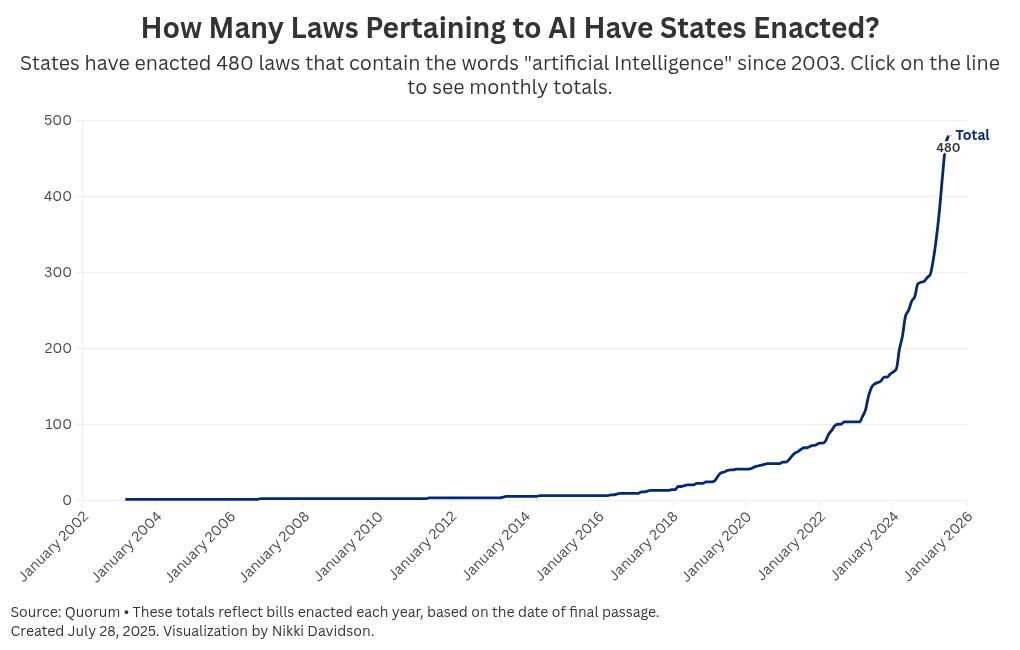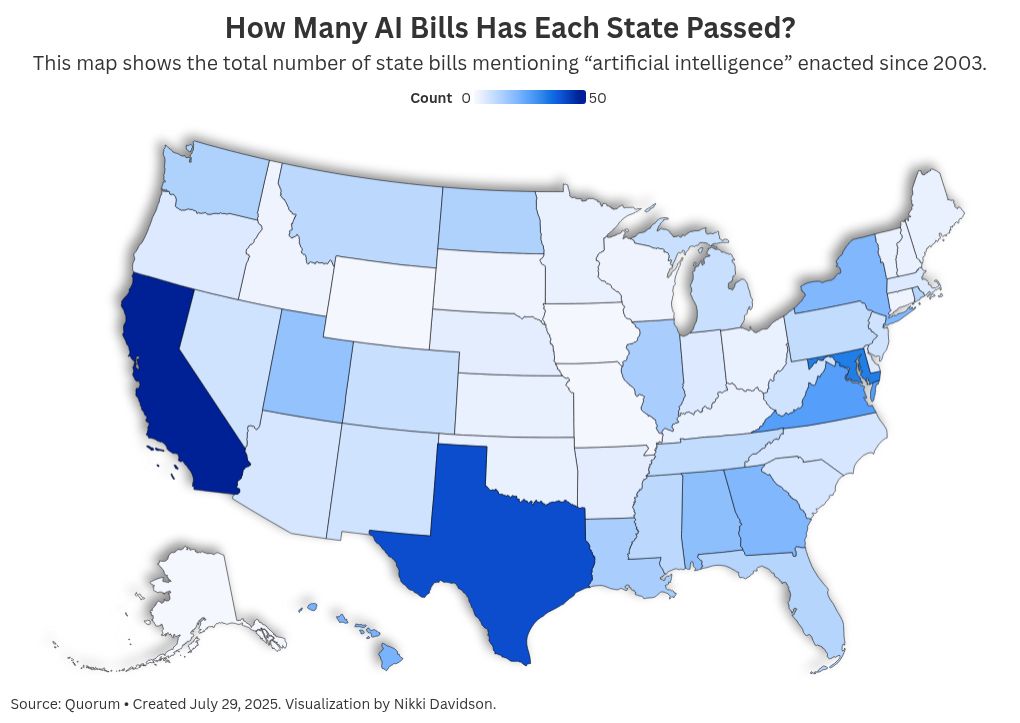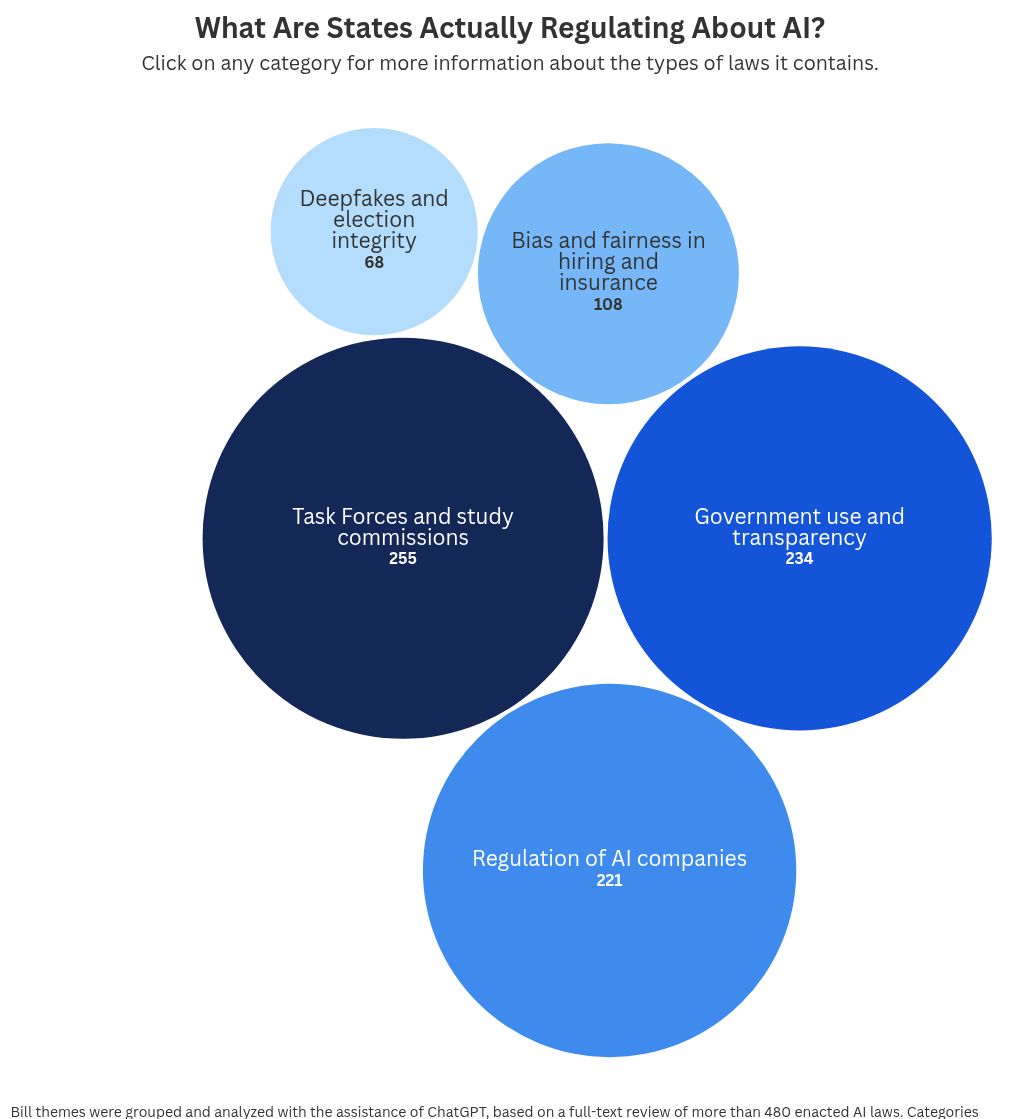President Donald Trump’s newly released AI action plan could have significant impacts on states, potentially jeopardizing federal funding if the regulations they pass are determined to be “burdensome” or “restrictive to innovation.”
To understand what this new policy shift might mean in practice, Government Technology analyzed hundreds of state-level AI laws and regulations to get a clearer picture of how and where state governments are already acting on AI.
WHAT TO KNOW ABOUT THE NEW ORDER
When Trump signed America’s AI Action Plan at an AI summit in Washington, D.C., he made the case for a single federal standard to govern AI. He warned that patchwork rules across 50 states could hinder innovation.
He acknowledged the message might be “unpopular,” but argued it was necessary for the U.S. to become the world’s undisputed leader in AI technology. This comes weeks after Congress decided not to enact a proposed moratorium that would have banned state and local governments from enforcing the many AI regulations for a period of 10 years from the One Big Beautiful Bill before it passed into law.
“If you are operating under 50 different sets of state laws, the most restrictive state of all will be the one that rules,” Trump said at the AI summit. “You could have a state run by a crazy governor, a governor that hates you, a governor that’s not smart, or maybe a governor that’s very smart but decides that he doesn’t like the industry, he can put you out of business because you’re going to have to go to that lowest common denominator.”
Watch Trump’s comments on state-level AI regulation in the video below.
A NEW ROLE FOR THE FCC
The new executive order calls for the Federal Communications Commission (FCC) to evaluate whether state AI regulations interfere with the agency’s ability to carry out its obligations and authorities under the Communications Act of 1934. The FCC has in the past served as a referee of sorts for telecom and digital infrastructure.
This directive could allow the FCC to challenge or pre-empt state laws that it sees as obstructing federal authority, especially in areas like broadband, content moderation and AI in digital services.
WHAT AI REGULATIONS ARE STATES ACTUALLY PASSING?
To provide context on what the regulatory landscape looks like in states, Government Technology collected data using Quorum, a website that tracks legislative activity at the state level.
We searched for bills that included the term “artificial intelligence” to reveal how many bills were introduced and how many became law.
There are limitations with this method, as not all bills with this language directly regulate AI, some may only mention it in passing. The analysis focuses on laws passed by state legislatures and does not include executive orders or administrative directives from governors, which are increasingly shaping AI policy.
WHAT THE DATA REVEALS
More than 1,100 bills with the words “artificial intelligence” have been introduced since 2003.
About 41 percent of them have become law. That’s higher than average according to Quorum data, as this year there have been at least 98,400 bills introduced in the country, while only about 30 percent became law.
There’s a clear surge in laws passed pertaining to artificial intelligence, especially in 2025. In May 2025 alone, 45 new bills with “artificial intelligence” became law.
To determine which states have been the most active at passing these bills, we charted them on a map, with darker shades to signify states that had the most enacted AI bills.
The results revealed a bipartisan landscape. Although California leads the country with 47 bills enacted with the the words “AI,” Texas is the runner up with 40.
Other legislatively active states include Maryland (32), Virginia (25), Hawaii (20), New York (19), Georgia (19), Alabama (17) and Utah (16).
WHAT THE DATA DOESN’T CAPTURE
While this data shows where AI legislation is happening, it doesn’t tell us how restrictive or innovation-friendly those laws might be.
To provide further context, we used an AI tool, GPT‑4o, to summarize and group common themes of the 480 pieces of legislation that have become law. Several laws, 273 out of 480, were grouped under more than one theme, based on the content of what the law mandated.
Task Forces & Study Commissions (255 bills): The most common approach for state legislation has been to create task forces and committees to study AI tools and their impact on society or the economy, and use that knowledge to create recommendations or shape future policy.Government Use & Transparency (234 bills): Many states are passing legislation about how state governments themselves can use AI. These rules mandate states create inventories of their AI tools and conduct audits to ensure responsible and transparent use by state government workers.Regulation of AI Companies (221 bills): This category most closely aligns with Trump’s concerns. These rules require disclosure of AI use to consumers, safety or accuracy standards and restrictions on the type of ways AI can be used.Bias and Fairness in Hiring/Insurance (108 bills): Several states mandate bias audits, prohibit discriminatory AI-based decisions and require transparency in hiring or insurance applications.Deepfakes and Election Integrity (68 bills): Some states have criminalized deceptive deepfakes, especially when used in elections or to create sexually explicit content.A FEDERAL VS. STATE DIVIDE
In an executive order, Trump prohibited federal agencies from buying AI models that reflect what he described as “woke” principles such as diversity, equity and inclusion or critical race theory.
As the analysis revealed that preventing bias and ensuring fairness has become an area of focus for state-level AI legislation, that reveals a potential divide between federal and state priorities in the AI landscape.
Ultimately, Trump’s stated AI objective is for the U.S. to lead the AI race across the globe, and his orders seek to get states out of the way of that goal.
“We can’t stop it with politics, we can’t stop it with foolish rules and even stupid rules. We want to have rules, but they have to be smart, they have to be brilliant,” Trump said during his address at the AI summit. “Winning this competition will be a test of our capacities, unlike anything since the dawn of the space age.”




